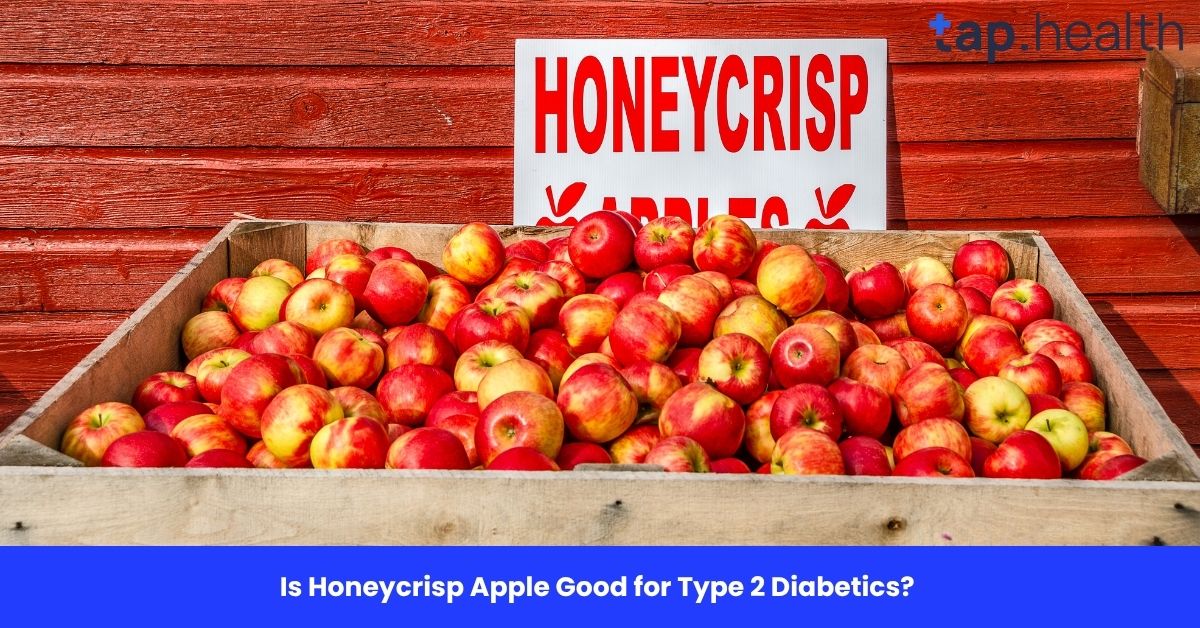When managing type 2 diabetes, making the right food choices is crucial. One common question that arises is whether or not certain fruits, like the Honeycrisp apple, are suitable for individuals with type 2 diabetes. Honeycrisp apples are widely loved for their crisp texture, sweet-tart flavour, and versatility in various recipes. But how do they fit into a diabetic diet?
In this article, we will explore everything you need to know about Honeycrisp apples and their benefits for people with type 2 diabetes. From understanding the glycemic index to discussing other health benefits, this guide will help you make informed decisions about including Honeycrisp apples in your diet.
What is Type 2 Diabetes?
Before diving into the specifics of Honeycrisp apples, it’s important to understand what type 2 diabetes is and how it affects the body. Type 2 diabetes is a chronic condition that affects how the body metabolises sugar (glucose). Unlike type 1 diabetes, where the body does not produce insulin, in type 2 diabetes, the body becomes resistant to insulin or doesn’t use it effectively.
This results in elevated blood sugar levels, which can lead to various health complications if not managed properly. One key way to manage type 2 diabetes is through diet, as food choices directly affect blood sugar levels. Fruits, especially those with a high glycemic index (GI), can cause rapid spikes in blood sugar, making it essential to choose wisely.
What is the Glycemic Index (GI)?
The glycemic index (GI) is a scale that ranks foods based on how quickly they raise blood sugar levels after consumption. Foods with a high GI (70 or more) cause rapid spikes in blood sugar, while foods with a low GI (55 or less) are digested and absorbed more slowly, leading to a gradual increase in blood sugar.
For people with type 2 diabetes, choosing foods with a low GI is generally recommended. These foods help manage blood sugar levels and avoid the risk of blood sugar spikes. On the other hand, high-GI foods can cause blood sugar levels to spike quickly, which may be harmful to someone with diabetes.
Glycemic Index of Honeycrisp Apples
So, where do Honeycrisp apples stand on the glycemic index? Honeycrisp apples fall under the low-to-medium GI category. The glycemic index of a Honeycrisp apple typically ranges from 36 to 40. This means that they are a low-GI fruit, which is a positive characteristic for someone managing type 2 diabetes.
Low-GI foods like Honeycrisp apples are digested more slowly, allowing the sugar to be released gradually into the bloodstream. This helps avoid sudden spikes in blood sugar, making them a safer fruit option for people with diabetes.
Are Honeycrisp Apples Safe for Type 2 Diabetics?
1. Low Glycemic Index Helps Manage Blood Sugar
As mentioned earlier, the glycemic index of Honeycrisp apples is on the lower end of the spectrum. This makes them a safe and healthy option for type 2 diabetics. Since they do not cause rapid spikes in blood sugar, they can be included in a diabetic meal plan without the risk of causing a blood sugar spike.
The fiber content in Honeycrisp apples also contributes to their low GI. The fiber slows the absorption of sugars, helping keep blood sugar levels stable.
2. Rich in Nutrients and Antioxidants
Honeycrisp apples are loaded with essential nutrients such as vitamin C, potassium, and fiber. These nutrients not only support overall health but also have specific benefits for people with diabetes.
- Vitamin C helps boost the immune system and supports skin health, which is important for diabetics who may have a higher risk of infections.
- Potassium plays a role in regulating blood pressure, which is often a concern for people with diabetes.
- Fiber contributes to good digestive health and helps maintain stable blood sugar levels.
Moreover, Honeycrisp apples contain a range of antioxidants, which help combat oxidative stress and inflammation, both of which are commonly associated with diabetes.
3. Aid in Weight Management
For type 2 diabetics, maintaining a healthy weight is key to managing the condition. Overweight individuals with type 2 diabetes may struggle with insulin resistance. Honeycrisp apples are low in calories but high in water and fiber, making them a filling and satisfying snack. The fiber helps you feel full longer, which can prevent overeating and promote weight loss.
By including low-calorie, high-fiber foods like Honeycrisp apples, you can manage your weight more effectively, which in turn can help improve insulin sensitivity and control blood sugar levels.
4. Improves Heart Health
Type 2 diabetes often increases the risk of developing heart disease. Honeycrisp apples can play a role in promoting heart health. They contain soluble fiber, which helps reduce LDL cholesterol (bad cholesterol) levels, a key risk factor for heart disease.
Additionally, the antioxidants and flavonoids found in Honeycrisp apples may help reduce inflammation, lower blood pressure, and improve overall cardiovascular health. Maintaining a healthy heart is essential for those with type 2 diabetes, as they are at a higher risk of heart complications.
also read this: How Many Calories in a Honeycrisp Apple?
How to Incorporate Honeycrisp Apples Into a Diabetic Diet
While Honeycrisp apples are a great choice for people with type 2 diabetes, moderation is key. Here are some ways to include them in your diet:
1. Snack on Them Fresh
The simplest way to enjoy Honeycrisp apples is by eating them fresh. They’re naturally sweet, crunchy, and satisfying, making them a perfect snack to help curb cravings for sugary foods.
2. Add to Salads
Slice Honeycrisp apples into your salads to add a sweet and crunchy texture. Combine with leafy greens, nuts, and a light dressing for a nutritious, diabetic-friendly meal.
3. Incorporate in Smoothies
Blend Honeycrisp apples into your smoothies for a natural sweetness. You can pair them with other low-GI fruits like berries, spinach, or Greek yogurt for a delicious and filling drink.
4. Bake Them Into Healthy Desserts
Honeycrisp apples can be baked into healthy desserts like apple crisps or applesauce. Be sure to use minimal added sugar or sweeten with natural alternatives like cinnamon for a diabetes-friendly treat.
5. Pair with Protein or Healthy Fats
To keep your blood sugar stable, pair Honeycrisp apples with a source of protein or healthy fats. Try slicing them and pairing them with peanut butter, almond butter, or a handful of nuts for a balanced snack.
Are Honeycrisp Apples Better Than Other Apple Varieties for Diabetics?
While Honeycrisp apples have a low-to-medium GI, other apple varieties can be just as beneficial for type 2 diabetics. Some common apple varieties and their glycemic index include:
- Granny Smith apples: GI of 38
- Fuji apples: GI of 42
- Gala apples: GI of 38
- Red Delicious apples: GI of 41
As you can see, many apples fall within a similar GI range, making them suitable for people with diabetes. The key is to choose whole apples over processed apple products like juices or canned apples, which may contain added sugars that can spike blood sugar levels.
Potential Drawbacks of Honeycrisp Apples for Type 2 Diabetics
While Honeycrisp apples have many health benefits, there are a few things to keep in mind:
1. Portion Control is Important
Even though Honeycrisp apples are low on the glycemic index, they still contain natural sugars. Eating too many apples in one sitting could increase your overall carbohydrate intake and potentially cause blood sugar fluctuations. Therefore, it’s important to consume them in moderation as part of a balanced diet.
2. Monitor Blood Sugar Levels
As with any food, it’s important to monitor how Honeycrisp apples affect your blood sugar. Every person’s body responds differently, so testing your blood sugar levels after eating an apple can help you understand how your body reacts.
Frequently Asked Questions (FAQs) on Is Honeycrisp Apple Good for Type 2 Diabetics?
1. Are Honeycrisp apples good for type 2 diabetes?
Yes, Honeycrisp apples are a great choice for type 2 diabetics. They have a low glycemic index, which means they release sugar into the bloodstream slowly and don’t cause rapid spikes in blood sugar.
2. How many Honeycrisp apples can a diabetic eat per day?
While Honeycrisp apples are healthy, it’s best to eat them in moderation. One medium-sized apple a day is generally safe for most people with type 2 diabetes. Pair it with a source of protein or healthy fat for a balanced snack.
3. Can Honeycrisp apples help with weight loss for diabetics?
Yes, Honeycrisp apples can aid in weight loss due to their high fiber and water content, which help you feel full for longer. They’re also low in calories, making them a great choice for a filling snack.
4. Do Honeycrisp apples have a high glycemic index?
No, Honeycrisp apples have a low-to-medium glycemic index (36–40), making them a suitable fruit for people with type 2 diabetes.
5. Can Honeycrisp apples cause a spike in blood sugar?
Honeycrisp apples have a low glycemic index, so they are less likely to cause a spike in blood sugar compared to high-GI foods. However, it’s important to eat them in moderation and monitor your blood sugar levels.
Conclusion
Honeycrisp apples are a delicious, nutritious, and diabetes-friendly fruit that can be safely included in a type 2 diabetic’s diet. With their low glycemic index, high fiber content, and numerous health benefits, they can help manage blood sugar levels, promote heart health, and support overall well-being. Always remember to consume them in moderation and pair them with other healthy foods to maintain balanced blood sugar levels.
So, the next time you’re craving a sweet, crisp snack, reach for a Honeycrisp apple and enjoy all the health benefits it offers.



